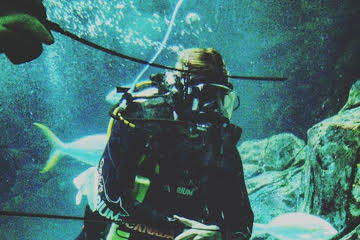 For Steven Rodenhizer, a combination of scuba diving, university and teaching would influence his career path.
For Steven Rodenhizer, a combination of scuba diving, university and teaching would influence his career path.
“I was enrolled in a science undergraduate degree majoring in biology by the time I achieved my open water diving certification. These two things combined ultimately determined that I wanted to focus on marine life and conservation.”
As a scientific diver working at Ripley’s Aquarium of Canada in Toronto, he uses an AGA full-face mask to speak to guests through the tank exhibits. This helps to “bridge the gap between beautiful underwater worlds and teaching people about why marine ecosystems are so vital.
“My daily routine has two major roles. First, I educate the general public about the impact of our carbon footprint on fragile marine species. I do this by speaking in front of an audience of 50 or more guests, while demonstrating alternative green options they can use to reduce their impact on the environment.”
“Second, I perform animal checkups and manage animal feeding schedules for the various ecosystem exhibits. This work requires me to have detailed knowledge of multiple marine species, as well as strong scuba diving skills, hands on experience working with animal species in captivity, and diving safety courses.
“I also perform daily dive shows, where I feed the marine animals such as stingrays, sharks, and tropical fish while communicating to the watching audience. I can leave an impact on the audience about the importance of maintaining and protecting the ecosystems of these marine species.”
Rodenhizer, 24, lives in Toronto but has travelled to top dive sites. “I had the amazing opportunity to dive the Great Barrier Reef in Australia. This is my favourite site to dive so far as I had never seen wild coral or such diverse ecosystems before. It was beautiful but the effects of climate change and over tourism was easily seen.”
Now a dive master, he was 20 when he took up scuba and did all his courses in Nova Scotia and Cape Breton.
“I decided to try diving because growing up I was constantly surrounded by water, doing water sports at our family cottage, teaching swimming lessons as a summer job, even becoming a National Life Guard. I figured scuba diving was the next logical step.”
Rodenhizer’s dream “bucket list” begins with the Silfra Fissure in Iceland. It is a crack between the North American and Eurasian continental plates. “There would not be much marine life to look at but just the fact you are diving between where two continents meet is thrilling.”
Rodenhizer likes dry-suit diving because it enables him to go to extreme cold environments to see organisms only visible while under ice. “It is astounding! For my job though being able to use a full face mask to communicate to kids and adults alike while diving with stingrays and sharks, really helps strike home the message of marine conservation and how important it is for our future.”





